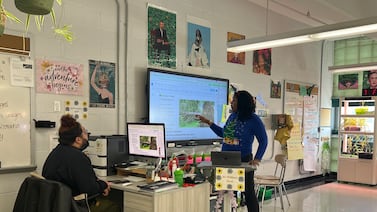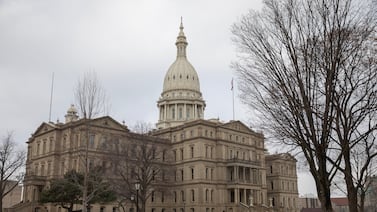Sign up for Chalkbeat Newark’s free newsletter to get the latest news about the city’s public school system delivered to your inbox.
Newark Public Schools has experienced a nearly 20% increase in enrollment over the past five years, a rare surge as districts across the country report a decline in students.
The district’s enrollment growth includes a rise in English language learners, students with disabilities, and Hispanic students, who now represent the largest student group in the district. Since 2019, the number of Black students has declined as Hispanic enrollment has steadily increased.
Newark’s surge in student enrollment since 2019 stands out as other public school districts cite decreasing or stagnant student populations. Public school enrollment across the country has dropped by nearly 1.3 million students since the COVID-19 pandemic, partly due to declining birth rates and shifts in migration. Statewide, enrollment grew by only 0.39%, according to a Chalkbeat analysis of state enrollment data.
In a press release on Wednesday, the district noted that it had the highest student enrollment growth of any of the 78 largest U.S. urban districts.
But it’s unclear exactly why Newark’s enrollment has increased so dramatically. Paul Brubaker, the district’s spokesperson, did not respond to multiple requests for comment about Newark’s growing public school enrollment.
In Newark, New Jersey’s largest school system, enrollment is shaped by changing demographics, homeschooling options, and school choice policies, among other factors.
Mark Weber, an education policy analyst at New Jersey Policy Perspective, said the city has seen an influx of Hispanic residents in recent years and a “significant growth” in the number of students who speak English as a second language. But whether those trends are related to Newark’s enrollment boost is unclear, Weber added.
“A 20% increase over five years, that’s a lot,” Weber said.
That growth comes as urban school districts around the country experience declining student enrollment, a trend that began before the pandemic, said Aaron Smith, director of education reform at Reason Foundation, a nonprofit think tank that analyzed national K-12 enrollment data.
“I think you can conclude that public school enrollment is plummeting and will continue to fall for years to come. But of course, the situation is local, and local context is key,” Smith said.
This school year, Newark Public Schools enters its fifth year of local control and has seen steady improvements in state test scores, declines in chronic absenteeism, and the opening of new schools. The district last year also spent more than a quarter of a million dollars to rehire a Memphis-based marketing firm to recruit students into district schools.
But, last week, parents at a public hearing to extend Superintendent Roger León’s contract raised concerns about student achievement, racism in schools, and inadequate support for the district’s most vulnerable students, highlighting questions about whether the district is meeting the needs of all students as enrollment grows.
Newark’s enrollment growth sets it apart from other school districts
Last school year, the district enrolled almost 44,000 pre-K through 12th grade students, up from roughly 36,600 in 2019, according to state enrollment figures. That’s just over 7,000 students who have enrolled in the district since 2019. The district also surpassed charter school growth in 2023, according to a Chalkbeat analysis of pre-K through 12 state enrollment data between 2019 and 2024.
In Essex County, Newark’s public schools have reported the biggest enrollment percentage gains in recent years. Essex Regional Educational Services Commission had a 13.16% growth, Irvington Public Schools experienced an 11.99% boost, and Orange Public Schools had an 11.94% increase, a Chalkbeat analysis found.
Newark’s growth makes it an outlier among other urban school districts in the country. Neighboring New York City has lost some 100,000 students since before the pandemic. Philadelphia schools are down nearly 10,000 students since the 2019-20 school year, and Chicago Public Schools enrollment has dipped by roughly 30,000 students since the 2019-20 school year, according to a Chalkbeat analysis.
A closer look at Newark Public Schools’ enrollment shows that the number of Hispanic students increased by roughly 40% over the last five years and accounts for almost all of the district’s 20% growth since 2019, according to a Chalkbeat analysis of state enrollment data. That’s a sharp contrast from pre-pandemic years, when Black student enrollment was steadily growing at the same rate as Hispanic students. Last school year, the district enrolled more than 26,000 Hispanic students; just under 14,000 students were Black.
The enrollment shifts are on par with demographic changes in Newark. According to the latest U.S. Census figures, Newark is home to more than 317,000 people, with roughly 114,000 identifying as Hispanic or Latino and just over 140,000 identifying as Black or African American.
Last school year, the district enrolled more than 12,000 English learners, according to state fall enrollment data. The number of English learner students rose almost sixfold in 2024 compared to 2019, according to a Chalkbeat analysis of district enrollment figures. In 2022, the district also experienced its most significant growth in English learners.
As the student makeup shifts, district officials are also facing urgent questions about the way they provide resources to students, determine capacity demands, and plan long-term to meet the needs of all students.
Smith, the director at Reason Foundation, added that school districts like Newark that receive state funding based on student enrollment are better equipped to absorb growing populations. In New Jersey, student enrollment numbers are used to calculate how much funding a district gets from the state.
“Generally, it might put a little pressure on the facilities side of things, but otherwise, [school districts] will have to find new talent and hire new staff, which they’ll get the additional resources to do so,” Smith added.
The surge in vulnerable student populations prompted Newark to launch a new bilingual education program at Malcolm X Shabazz High School last fall to help English learners access services closer to where they live. At the same time, some students with disabilities missed class during the first week of the 2024-25 school year after being told they did not have a school placement.
Smith added that enrollment changes “don’t just impact the school system,” they also dictate how a district will have to operate during the school year.
“Schools are just going to have to adjust to their new enrollment reality, and part of that is dealing with staffing issues and sometimes, school closures or budget cuts, which are difficult but necessary,” Smith said.
Jessie Gomez is a reporter for Chalkbeat Newark, covering public education in the city. Contact Jessie at jgomez@chalkbeat.org.





